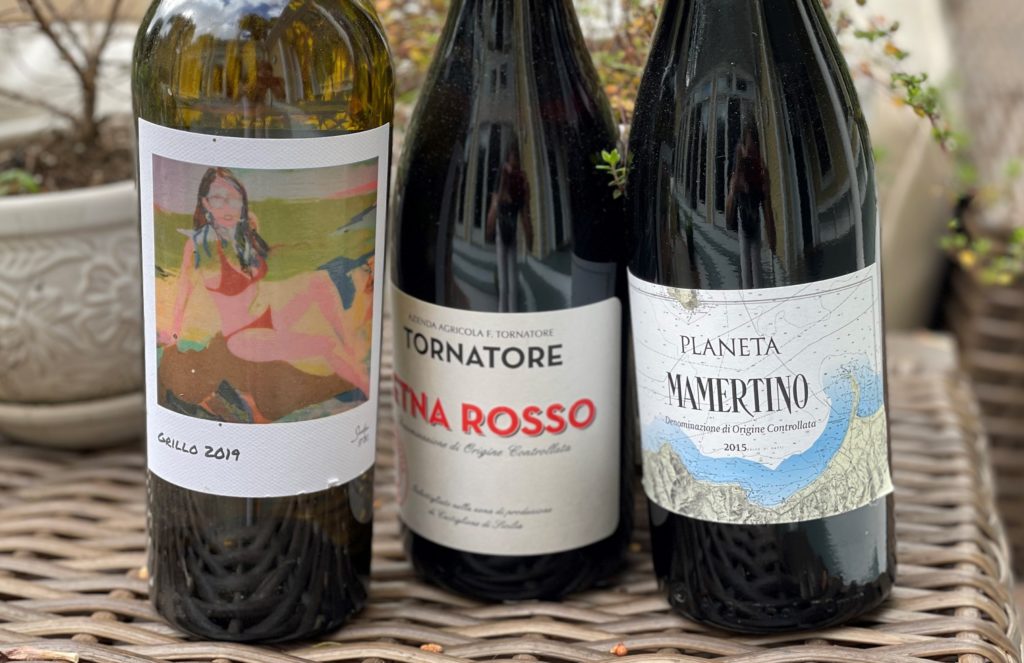Sicily…a volcanic island in the Mediterranean, is more than just a beautiful vacation spot and home to “The Godfather”. It also has a fantastic array of indigenous grape varieties that make some of my favorite wines. One of my go-to everyday red wines is single varietal Nero D’Avolo, which you may have already tried. Today I’ll introduce you to three more unusual wines – one white (Grillo) and two reds (Etna Rosso and Mamertino) – and they may become some of your favorites too.
Last week we had a wine dinner and paired 5 different Sicilian wines with an authentic four course meal prepared by an Italian private chef. The meal was fantastic, and it made me realize just how great the wines are in Sicily.
Sicily is blessed with a rich history and tradition of winemaking that goes back to the Phoenicians. Because it has been Italian, French, Spanish and even controlled by Arabs over the centuries, both the food and the wines have developed a very particular style that is unique to the island.

Grillo
Grillo is a Sicilian white grape variety most famous for its role in the island’s fortified Marsala wines. Although Marsala is now relegated to mainly cooking wine, it is still widely planted on Sicily. It has shown a resurgence as a single varietal or blended still white wine that pairs amazingly well with the local fare, especially seafood.
Some believe that the variety is native to Sicily, suggesting it is the progeny of Catarratto and Muscat of Alexandria. Others think it was brought to the island from the southern Italian region of Puglia. There is even some evidence to suggest that this was the variety in the Roman wine Mamertino, a particular favorite of Julius Caesar. Whatever its ancestry, it makes for a lovely wine that has a bit more character than the go-to Italian white, Pinot Grigio, and will definitely appeal to unoaked Chardonnay lovers.
Sicilian Winemaker Lucio Matricardi calls Grillo the” Cabernet of white wine”. Bold and complex with plenty of body, a fresh, light white wine with nutty, fruit-driven flavors that include lemon and apple. It is at its best when paired with food, including richer fish, such as swordfish or salmon, or chicken or pasta with a lemon cream sauce. But it is also nuanced with floral notes and hints of spices, dried fruits, and nuts.
Etna Rosso
The name means red wine of Etna, as in Mount Etna the volcano. I have a thing for volcanic wines, and the elegance and concentration they have, as well as stronger tannins and minerality (other volcanic regions include Napa and Willamette Valley). I researched and volcanic soils have a lot of potassium and iron, in addition to other nutrients, and have good drainage.
Etna Posso is grown on the slopes of Mount Etna and is made from Nerello Mascalese and Nerello Cappuccio, two indigenous black grapes of Etna. These grapes are rarely found anywhere else but in this region.
The grapes are hand harvested because they grow on very steep slopes. The maceration is extended to get more tannins and color out of the grapes. It can have some ageing in barrel and further ageing in the bottle.
Etna Rosso has a ruby red with faint purple, and is more pale to medium, reminiscent of a Pinot Noir. In fact, if you like Pinot Noir you will definitely like this wine!
On the nose, hints of red berries, morello cherry and black cherry, intense herbal and floral aromas. On the palate, balanced tannins and a surprising fullness, red fruit flavors and ashy minerality. Yum!
We paired this with saffron arancina (rice ball) filled with a light beef ragu and it was stunning. Poultry, pork, salmon and tuna would pair well, in addition to any red sauced pastas.
Mamertino
According to Planeta’s website the Mamertino DOC is “a denomination arising from the depths of antiquity, when the proud people of the Mamertini produced this wine, described by Pliny and loved by Julius Caesar, at Mylae (Milazzo)…. The little winery stands a short distance from the sea and is surrounded by spectacular vines that we planted on the promontory of Capo Milazzo.“ You can just imagine Roman winemakers working in view of the sea creating this excellent wine for the tables of the elite. This wine style has been around since antiquity and is just now gaining interest with consumers.
Made of 60% Nero d’Avola and 40% Nocera, both indigenous varieties, this is a prime example of traditional Sicilian red wine. It has more depth and concentration thanks to 12 months maturing in 25hl casks. If you like Merlot or a New World Syrah/Shiraz, you will enjoy this wine.
Nero d’Avola is Sicily’s most important grape variety, It was imported by Greeks during their settlement of Sicily before the Romans; the “low-lying” training was also brought into use by them, as this grape is typically trained in espalier or tree fashion.
Nocera, another local grape, is able to retain good acidity even in the scorching Sicilian heat. It has prominent tannins, thanks to its thick-skinned berries, which make for structured wines with serious palate weight. Nocera brings high alcohol as well as an intense yet elegant bouquet of dark fruit flavors, leather and spice.
This wine has an explosive nose with notes of Mediterranean maquis 9the scrub evergreens and trees that grow wild along the coast), black fruits and jammy berries. This wine pairs well with roasted or grilled white or red meats, and any heartier cuisine including richer fish like tuna.
I hope you’ll try some of these wines and experience the uniqueness and quality of these very regional wines.



